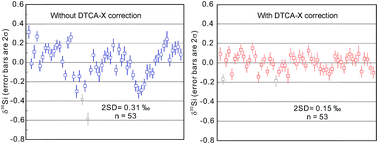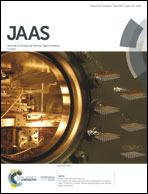Ultra-high precision silicon isotope micro-analysis using a Cameca IMS-1280 SIMS instrument by eliminating the topography effect†
Abstract
Silicon (Si) is the second most abundant element in the silicate Earth. Secondary ion mass spectrometry (SIMS) was previously applicable only for low temperature geological processes because of its relatively low precision (±0.3‰, 2SD) when used to measure limited Si isotopic variations in high temperature geological processes. To extend the application of Si isotopes, a SIMS protocol for ultra-high precision and accuracy Si isotope measurements was developed in this study using a Cameca IMS-1280. By using high primary beam intensities (10 to 14 nA) and a long acquisition time (160 s), an internal precision of ±0.07‰ (2SE) and external precision (reproducibility) of ±0.10‰ (2SD) were achieved for spot-to-spot analysis on a perfectly flat surface (NIST610 glass). The topography effect significantly degraded the external precision for small-grained quartz crystals. Fortunately, there is a tight correlation between measured δ30Si and a secondary beam centering parameter (DTCA-X value). By using the DTCA-X correction, both the external repeatability and accuracy were improved. The Si isotope analysis of nine unknown quartz samples by using this newly developed SIMS method was in good agreement (within ±0.1‰ uncertainty) with solution MC-ICP-MS results.



 Please wait while we load your content...
Please wait while we load your content...